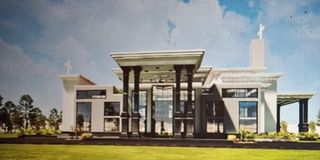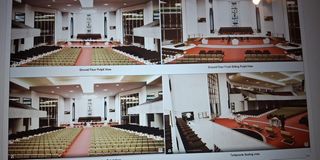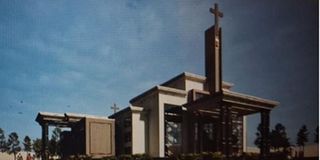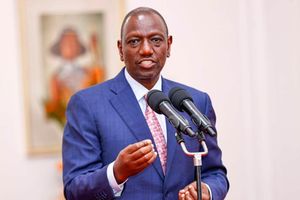
The Western view in daytime of the massive church whose construction is ongoing within the grounds of State House, Nairobi.
With President William Ruto confirming on Friday that he is constructing a grand church inside the State House precincts, echoes of what other African rulers have done start reverberating.
From Mobutu Sese Seko in Zaire to Nana Akufo-Addo in Ghana and Abdelaziz Bouteflika in Algeria, rulers have mooted massive worship sites, often drawing controversy.
Dr Ruto’s multi-million-shillings project has kicked up a storm because Kenya has no State religion as per the Constitution. Also, despite him insisting that he will bankroll the construction from his pocket, questions linger on the probity of it all.
Regardless, Weekly Review research shows that most of them have done constructions in separate sites and not in their official residences.
In the case of Mobutu, a grand church called Chapelle de la Miséricorde (a name borrowed from one chapel in France) was located in his private palace in Gbadolite, a residence he built after tearing down part of a forest.
It was outside that chapel that Mobutu buried his first wife, Marie-Antoinette. Mobutu ruled Zaire from 1965 to 1997. A 1993 article by Time magazine noted that Mobutu seldom missed Sunday Mass.

Architectural designs of the massive church whose construction is ongoing within the grounds of State House, Nairobi.
“It is a ritual he has faithfully observed during his nearly 30 years of absolute power,” it reported then.
Congo Travel and Tours says on its website that the chapel in Mobutu’s palace, which was destroyed after Mobutu’s dethronement, had an “imposing metal cross and its twelve bells”.
The Voice of America reported in 2022 that the chapel was “made of marble, decorated with gold objects and other precious materials”, adding that at least three sons of Mobutu and Marie-Antoinette were buried there. It added that the chapel was constructed in 1978.
The vicious destruction of the chapel and the defacing of the burial sites were clear indicators that the public did not have the slightest reverence for the church.
Elsewhere, controversy arose in Ghana two years ago as President Akufo-Addo championed the construction of an interdenominational national cathedral about 700 metres from the country’s parliament.
National cathedral
As reported by Al Jazeera, President Akufo-Addo (who ruled between January 2017 and January 2025) wanted to build the cathedral for “the glory and honour” of God. He said in 2020 that that is a promise he had made to God before his election.
Just like Dr Ruto’s project, there was controversy regarding the financing.

The Western view in daytime of the massive church whose construction is ongoing within the grounds of State House, Nairobi.
“Funding for the national cathedral has been shrouded in secrecy, but last year, the secretariat in charge of the project said the cost, initially estimated at $100 million (Sh12.9 billion on today’s rates), has now quadrupled due to inflation,” Al Jazeera noted.
The country’s finance minister said in 2019 that the costs were to be covered by donations and that the government was “providing only the land” and “seed money for the preparatory phase”. This was later proven false, Al Jazeera reported, as the government footed most of the bill.
A number of Ghanaians were opposed to the project, with some seeing it as an excuse to tap cash from the national coffers.
“I don’t think any Ghanaian is complaining about where to worship,” actor and activist Yvonne Nelson told Al Jazeera.
A 2023 report by the US Department of State said critics “were questioning whether the cathedral…should be a priority for a country with urgent development needs”.

The Western entry view in daytime of the massive church whose construction is ongoing within the grounds of State House, Nairobi.
Ghana aside, Equatorial Guinea has also had a leader controversially involved with a place of worship.
In an article published in May this year by the International Consortium of Investigative Journalists (ICIJ), written from various leaked documents, President Obiang Nguema is fingered for a church being built in his hometown of Mongomo. Mongomo is about 450 kilometres by road from the capital, Malabo, and President Nguema has been in power since 1979.
“The Basilica of the Immaculate Conception — the second-largest religious building in Africa — is loosely modelled on the Vatican’s St Peter’s Basilica. The Swiss- and Italian-built church is large enough to accommodate a thousand parishioners under its massive dome but was deserted when ICIJ visited,” the consortium reported.
Architectural designs of the massive church, whose construction is ongoing within the grounds of the State House, Nairobi.
It noted that President Nguema’s government is fixated with “grand engineering works at the expense of building schools, hospitals and housing”.
Elsewhere in northern Africa, a mosque that was built over a seven-year period is a talking point.
Grand Mosque of Algiers
It is called the Grand Mosque of Algiers, located along Algeria’s Mediterranean coastline. Al Jazeera reported in 2024 that critics were describing it as a “vanity project for former president [Abdelaziz Bouteflika] who tried to name it after himself”.
The temple was inaugurated in 2024 by Algeria’s president Abdelmadjid Tebboune, who has been the president since 2019.
At the time of its launch, Al Jazeera said, it was “the world’s third-largest and Africa’s largest mosque”.
“Known locally as the Djamaa El-Djazair, it features the world’s tallest minaret at 265 metres, can accommodate 120,000 people, and is the world’s largest mosque only after Islam’s holiest sites in Saudi Arabia’s Mecca and Medina,” the outlet noted.
An architectural drawing of the massive church whose construction is ongoing within the grounds of State House, Nairobi.
Built for $900 million (Sh116.1 billion) by a Chinese firm, the project had many critics. Al Jazeera noted that it was one of the initiatives under President Bouteflika’s 20-year rule that involved “suspected kickbacks to state officials paid by the contractors”.
In Ivory Coast, the Basilica of Our Lady of Peace, constructed by President Felix Houphouët-Boigny in his native homeland of Yamoussoukro, is another example. When he chose Yamoussoukro to be the political capital of the country in the early 1980s, he lined up the massive church as part of the structures. With a capacity of 18,000, the lavish church was constructed with marble imported from Italy and stained glass from France. The basilica needed 8,400 square metres of glass to complete, according to the French supplier that provided the glass. President Houphouët-Boigny was in power from 1960 until his death in 1993.








